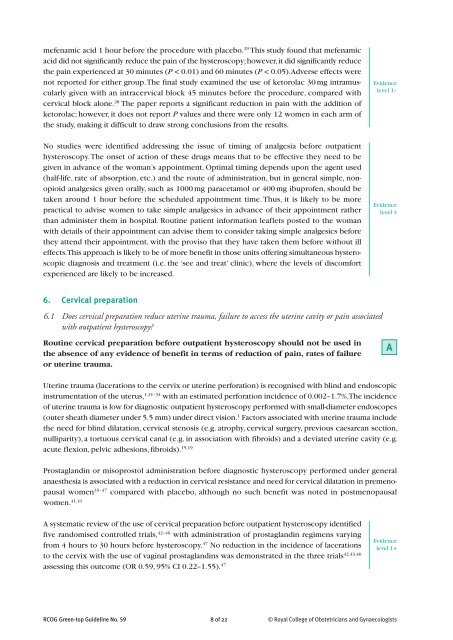Best Practice in Outpatient Hysteroscopy - British Society for ...
Best Practice in Outpatient Hysteroscopy - British Society for ...
Best Practice in Outpatient Hysteroscopy - British Society for ...
You also want an ePaper? Increase the reach of your titles
YUMPU automatically turns print PDFs into web optimized ePapers that Google loves.
mefenamic acid 1 hour be<strong>for</strong>e the procedure with placebo. 29 This study found that mefenamic<br />
acid did not significantly reduce the pa<strong>in</strong> of the hysteroscopy;however,it did significantly reduce<br />
the pa<strong>in</strong> experienced at 30 m<strong>in</strong>utes (P < 0.01) and 60 m<strong>in</strong>utes (P < 0.05).Adverse effects were<br />
not reported <strong>for</strong> either group.The f<strong>in</strong>al study exam<strong>in</strong>ed the use of ketorolac 30 mg <strong>in</strong>tramuscularly<br />
given with an <strong>in</strong>tracervical block 45 m<strong>in</strong>utes be<strong>for</strong>e the procedure, compared with<br />
cervical block alone. 28 The paper reports a significant reduction <strong>in</strong> pa<strong>in</strong> with the addition of<br />
ketorolac; however, it does not report P values and there were only 12 women <strong>in</strong> each arm of<br />
the study, mak<strong>in</strong>g it difficult to draw strong conclusions from the results.<br />
No studies were identified address<strong>in</strong>g the issue of tim<strong>in</strong>g of analgesia be<strong>for</strong>e outpatient<br />
hysteroscopy.The onset of action of these drugs means that to be effective they need to be<br />
given <strong>in</strong> advance of the woman’s appo<strong>in</strong>tment. Optimal tim<strong>in</strong>g depends upon the agent used<br />
(half-life, rate of absorption, etc.) and the route of adm<strong>in</strong>istration, but <strong>in</strong> general simple, nonopioid<br />
analgesics given orally, such as 1000 mg paracetamol or 400 mg ibuprofen, should be<br />
taken around 1 hour be<strong>for</strong>e the scheduled appo<strong>in</strong>tment time. Thus, it is likely to be more<br />
practical to advise women to take simple analgesics <strong>in</strong> advance of their appo<strong>in</strong>tment rather<br />
than adm<strong>in</strong>ister them <strong>in</strong> hospital. Rout<strong>in</strong>e patient <strong>in</strong><strong>for</strong>mation leaflets posted to the woman<br />
with details of their appo<strong>in</strong>tment can advise them to consider tak<strong>in</strong>g simple analgesics be<strong>for</strong>e<br />
they attend their appo<strong>in</strong>tment, with the proviso that they have taken them be<strong>for</strong>e without ill<br />
effects.This approach is likely to be of more benefit <strong>in</strong> those units offer<strong>in</strong>g simultaneous hysteroscopic<br />
diagnosis and treatment (i.e. the ‘see and treat’ cl<strong>in</strong>ic), where the levels of discom<strong>for</strong>t<br />
experienced are likely to be <strong>in</strong>creased.<br />
6. Cervical preparation<br />
6.1 Does cervical preparation reduce uter<strong>in</strong>e trauma, failure to access the uter<strong>in</strong>e cavity or pa<strong>in</strong> associated<br />
with outpatient hysteroscopy?<br />
Rout<strong>in</strong>e cervical preparation be<strong>for</strong>e outpatient hysteroscopy should not be used <strong>in</strong><br />
the absence of any evidence of benefit <strong>in</strong> terms of reduction of pa<strong>in</strong>, rates of failure<br />
or uter<strong>in</strong>e trauma.<br />
Uter<strong>in</strong>e trauma (lacerations to the cervix or uter<strong>in</strong>e per<strong>for</strong>ation) is recognised with bl<strong>in</strong>d and endoscopic<br />
<strong>in</strong>strumentation of the uterus, 1,31–34 with an estimated per<strong>for</strong>ation <strong>in</strong>cidence of 0.002–1.7%.The <strong>in</strong>cidence<br />
of uter<strong>in</strong>e trauma is low <strong>for</strong> diagnostic outpatient hysteroscopy per<strong>for</strong>med with small-diameter endoscopes<br />
(outer sheath diameter under 5.5 mm) under direct vision. 1 Factors associated with uter<strong>in</strong>e trauma <strong>in</strong>clude<br />
the need <strong>for</strong> bl<strong>in</strong>d dilatation, cervical stenosis (e.g. atrophy, cervical surgery, previous caesarean section,<br />
nulliparity), a tortuous cervical canal (e.g. <strong>in</strong> association with fibroids) and a deviated uter<strong>in</strong>e cavity (e.g.<br />
acute flexion, pelvic adhesions, fibroids). 15,19<br />
Prostagland<strong>in</strong> or misoprostol adm<strong>in</strong>istration be<strong>for</strong>e diagnostic hysteroscopy per<strong>for</strong>med under general<br />
anaesthesia is associated with a reduction <strong>in</strong> cervical resistance and need <strong>for</strong> cervical dilatation <strong>in</strong> premenopausal<br />
women 35–37 compared with placebo, although no such benefit was noted <strong>in</strong> postmenopausal<br />
women. 41,41<br />
A systematic review of the use of cervical preparation be<strong>for</strong>e outpatient hysteroscopy identified<br />
five randomised controlled trials, 42–46 with adm<strong>in</strong>istration of prostagland<strong>in</strong> regimens vary<strong>in</strong>g<br />
from 4 hours to 30 hours be<strong>for</strong>e hysteroscopy. 47 No reduction <strong>in</strong> the <strong>in</strong>cidence of lacerations<br />
to the cervix with the use of vag<strong>in</strong>al prostagland<strong>in</strong>s was demonstrated <strong>in</strong> the three trials 42,43,46<br />
assess<strong>in</strong>g this outcome (OR 0.59, 95% CI 0.22–1.55). 47<br />
Evidence<br />
level 1–<br />
Evidence<br />
level 4<br />
RCOG Green-top Guidel<strong>in</strong>e No. 59 8 of 22 © Royal College of Obstetricians and Gynaecologists<br />
A<br />
Evidence<br />
level 1+



